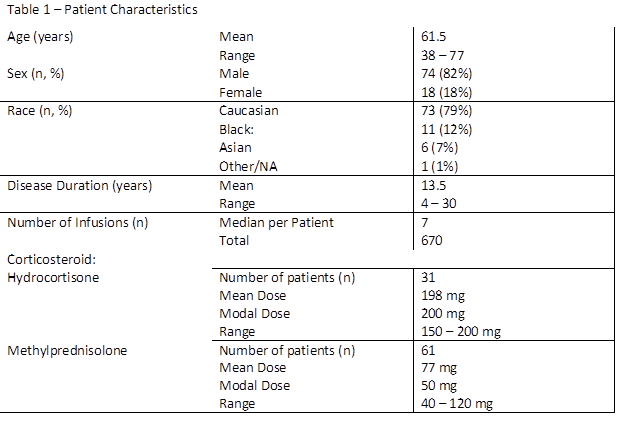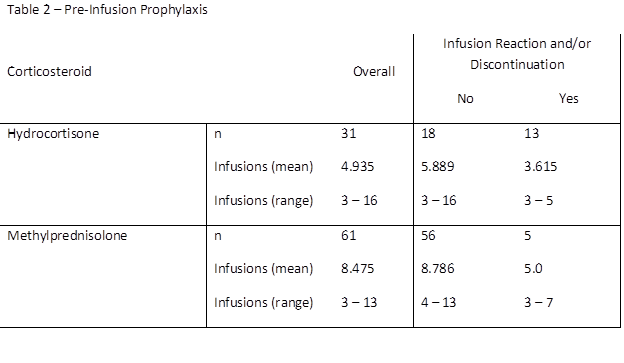Session Information
Date: Sunday, November 13, 2016
Title: Metabolic and Crystal Arthropathies - Poster I: Clinical Practice
Session Type: ACR Poster Session A
Session Time: 9:00AM-11:00AM
Background/Purpose: Corticosteroids are commonly utilized, along with other agents in clinical practice for pre-infusion prophylaxis prior to the administration of therapeutic biologic proteins. Two steroids, methylprednisolone and hydrocortisone, are commonly used. Because of the differing characteristics of these two agents, a chart review evaluating outcomes was performed.
Methods: Nineteen sites completed a retrospective chart review of pegloticase treated gout patients who completed at least three (3) infusions since 1/1/2012. Pegloticase is typically administered at 8 mg every 2 weeks, the FDA approved dose. Data collected included demographics, gout history, contraindications to both infusion reaction prophylaxis and gout flare prophylaxis medications, pre and post treatment serum uric acid (sUA) level, and prior gout treatment. This analysis includes data from 92 patients. Data were analyzed using multiple logistic regression, with number of infusions as a response variable and age, sUA prior to the last infusion, type of infusion prophylaxis corticosteroid (hydrocortisone or methylprednisolone) as treatment outcome predictor variables.
Results: Patient characteristics are similar to the typical pegloticase treated population.
Conclusion: Data from this retrospective chart review indicates that methylprednisolone pre-infusion therapy may allow for longer pegloticase therapy duration as compared with hydrocortisone. However, this modality imposes a significantly higher glucocorticoid load that may suppress symptoms of an infusion reaction rather than inhibit pegloticase drug antibody formation. The long term use of methylprednisolone prophylaxis may result in glucocorticoid related adverse effects. Methylprednisolone use as compared to hydrocortisone for infusion prophylaxis needs further study to determine efficacy and long-term safety.
To cite this abstract in AMA style:
Majjhoo A, Okposo K, Zdanis M. Prophylaxis for Infusion Reactions to Pegloticase: An Analyis of Two Different Corticosteroid Pre-Infusion Regimens in US Community Rheumatology Practices [abstract]. Arthritis Rheumatol. 2016; 68 (suppl 10). https://acrabstracts.org/abstract/prophylaxis-for-infusion-reactions-to-pegloticase-an-analyis-of-two-different-corticosteroid-pre-infusion-regimens-in-us-community-rheumatology-practices/. Accessed .« Back to 2016 ACR/ARHP Annual Meeting
ACR Meeting Abstracts - https://acrabstracts.org/abstract/prophylaxis-for-infusion-reactions-to-pegloticase-an-analyis-of-two-different-corticosteroid-pre-infusion-regimens-in-us-community-rheumatology-practices/


